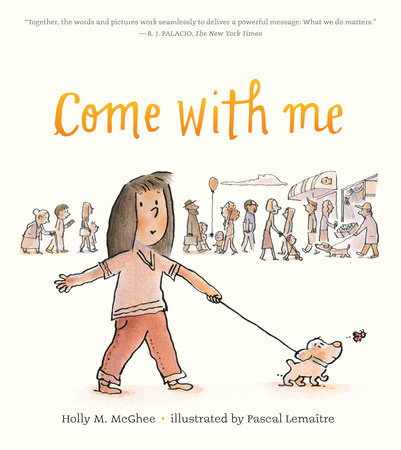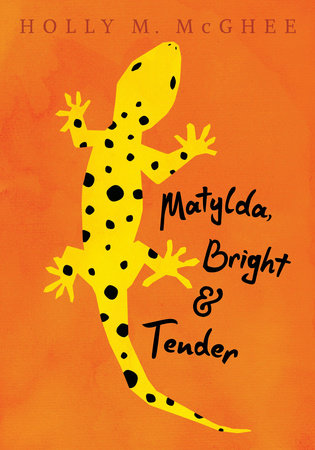Simple Gestures to Spark Greater Compassion: Holly McGhee on Her Timely Story for Children
by the Brightly Editors
Figuring out how to encourage children to be a force for good in the world can sometimes be a tough balancing act for parents. How do we talk about the need for empathy, kindness, compassion, and bravery in challenging times — and encourage our children toward these ideals — without overwhelming them with the difficult news of the day? One way is by introducing them to stories of children who are doing their small part to leave a positive mark on their community. In Come with Me, author Holly McGhee and illustrator Pascal Lemaître aim to do just that, telling the story of a young girl who, troubled by the news she sees on TV, asks her parents what she can do to make things better. Thus unfolds a subtle and inspiring tale of finding the courage to connect with one another and share the best of ourselves, in the hopes that it might spark others to do the same.
We chatted with Holly about the very personal inspiration for the book, her decades-long friendship with illustrator Pascal Lemaître, and why she thinks tiny gestures can change the world.
What was the inspiration for this book? Why did you feel that this was a story that needed to be told now?
It’s a story borne of a 17-year-friendship — Pascal reaching out to me and my 18-month-old daughter after 9/11 with a painting to show his concern (we lived in Manhattan) and me reaching out to him via email after the lockdown in Brussels that followed the attacks on Paris 15 years later (he lived in Brussels). We were reflecting on what mattered, amidst the anger and fear that seems so pervasive in the world, and what mattered was the idea of going on despite being afraid, finding ways to connect with and contribute something positive to humanity, however small that something might be.

The TV screen in Come with Me is blank except for noise. That’s because the world events that shaped this book have been replaced by new stories of anger and hatred. So I guess, unfortunately, Come with Me is a story that needs to be told again and again and again.
I believe each of us can act for good at our own level. Pascal had connected to me with art, and I had connected to him with words and so it made sense that we would use those two things to reach out to others through story, at a level that we hope even the youngest can grasp.
One of the key themes in the book is that to make the world a better place, you need to get out and engage with the world and with your fellow human beings. Can you talk a little bit about why you think this is important, particularly for kids?
I mentioned the lockdown in Brussels in the spring of 2016. I was watching CNN with my three children, the camera trained on an apartment where the terrorists were suspected to be. We were just lodged there, eyes on the screen, thinking about those who had died and been injured in the attacks on Paris and then Brussels. Then I went back in my mind to that painting Pascal had sent so long ago of a frightened grieving man planting a flag at the World Trade Center site, the flag bearing a big red heart blowing in the breeze — that small act of kindness he’d shown me somehow was the very thing that gave me the courage to go on despite the taut atmosphere in New York at the time. As a parent, I wanted my children to understand that a simple gesture of goodwill is sometimes the very thing that can help somebody most. Rather than sit and watch and feel powerless, we could perhaps find a way to connect with another person, especially in the face of tragedy and fear.
How do you think disconnecting from technology and from the steady stream of news and information can be of help in playing your part, so to speak, in making the world a better place?
Even as adults, I think it’s good to take a step back and remember who we are and what’s important to avoid being overwhelmed by the nonstop flow of news and images. Drawing, writing, breathing slowly — how we choose to step back is unique to each of us. In the book, drawing creates a place around which people gather like a fire in winter. Getting outside can bring the whole community together.
Can you tell us a bit more about your friendship with the illustrator, Pascal Lemaître? How did you come to collaborate on this book?
I am a literary agent in addition to being a writer, and Pascal was one of my first clients. I have always loved his drawings. We also became close friends over the years, him in Brussels and me in New York, checking in and looking out for each other.
He brought me the myth of the hummingbird, in which the smallest of all birds keeps bringing water to the forest fire. When the other animals ridicule it, the humming bird says, I DO MY PART. I realized that we could take that idea and set it against the current state of the world, and in so doing both remind ourselves and our readers and children that no matter how insignificant we sometimes feel, our part matters. Tiny gestures can start a revolution.
What’s one thing you hope young readers take away from the story?
I think our quote at the beginning of the book from Yvette Pierpaoli says it best. She was Pascal’s mother-in-law, who dedicated her life to helping refugees and died while doing just that in Kosovo. “Though at the level of the individual our actions are light as a cloud, united they can change the color of the sky.”
-
Books by Holly M. McGhee
-
Come with Me
Also available from:Matylda, Bright and Tender
Also available from:
Holly M. McGhee is the author of the middle grade novel, Matylda, Bright and Tender. She has also written picture books and a chapter book series under the pen name Hallie Durand, including Mitchell’s License and Mitchell Goes Bowling. A literary agent too, she lives with her family in Maplewood, New Jersey. You can visit her at hollymcghee.com.


